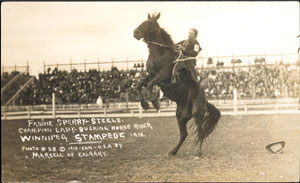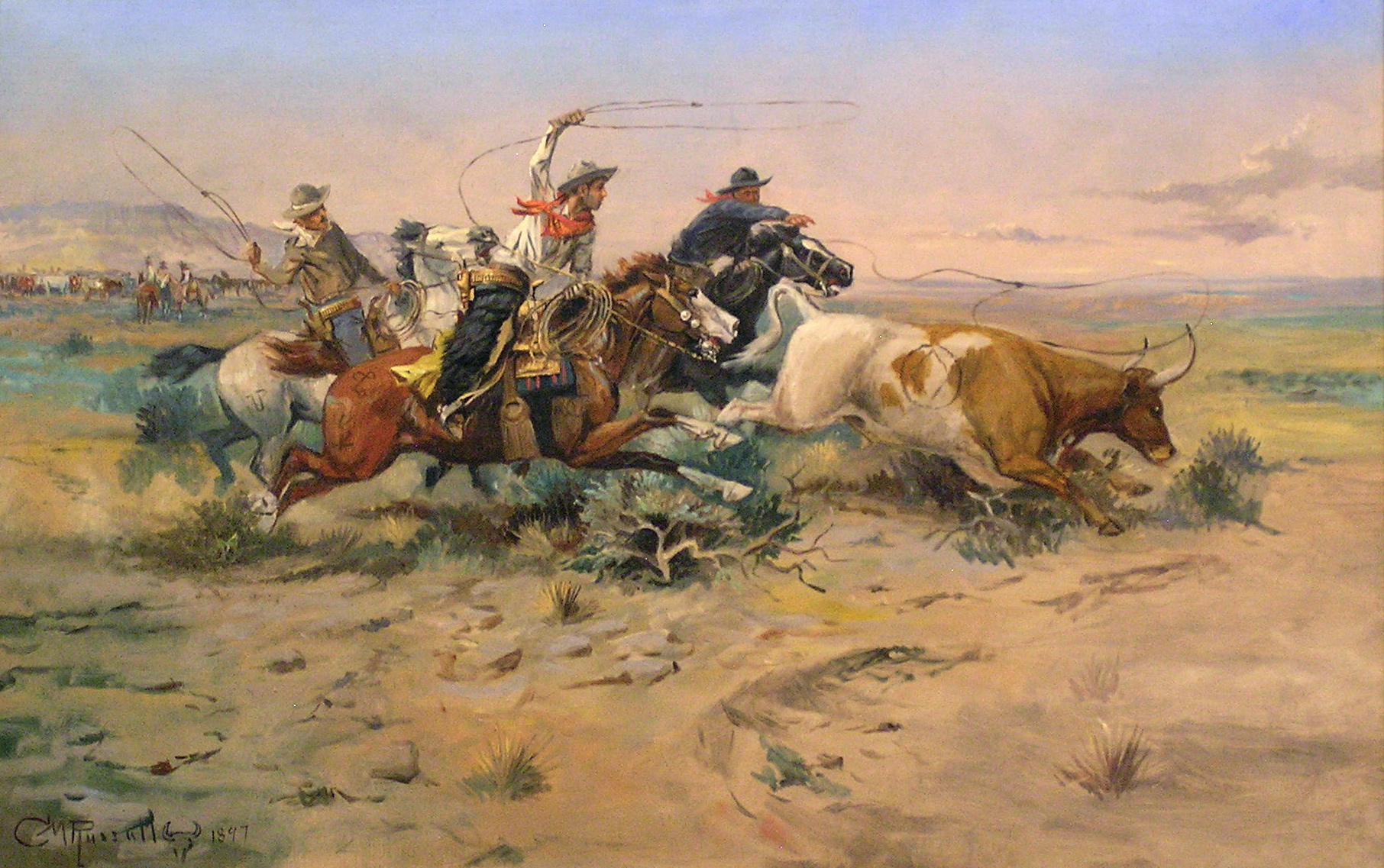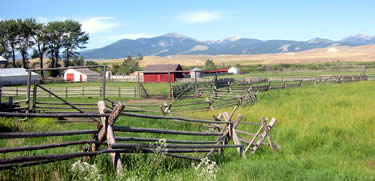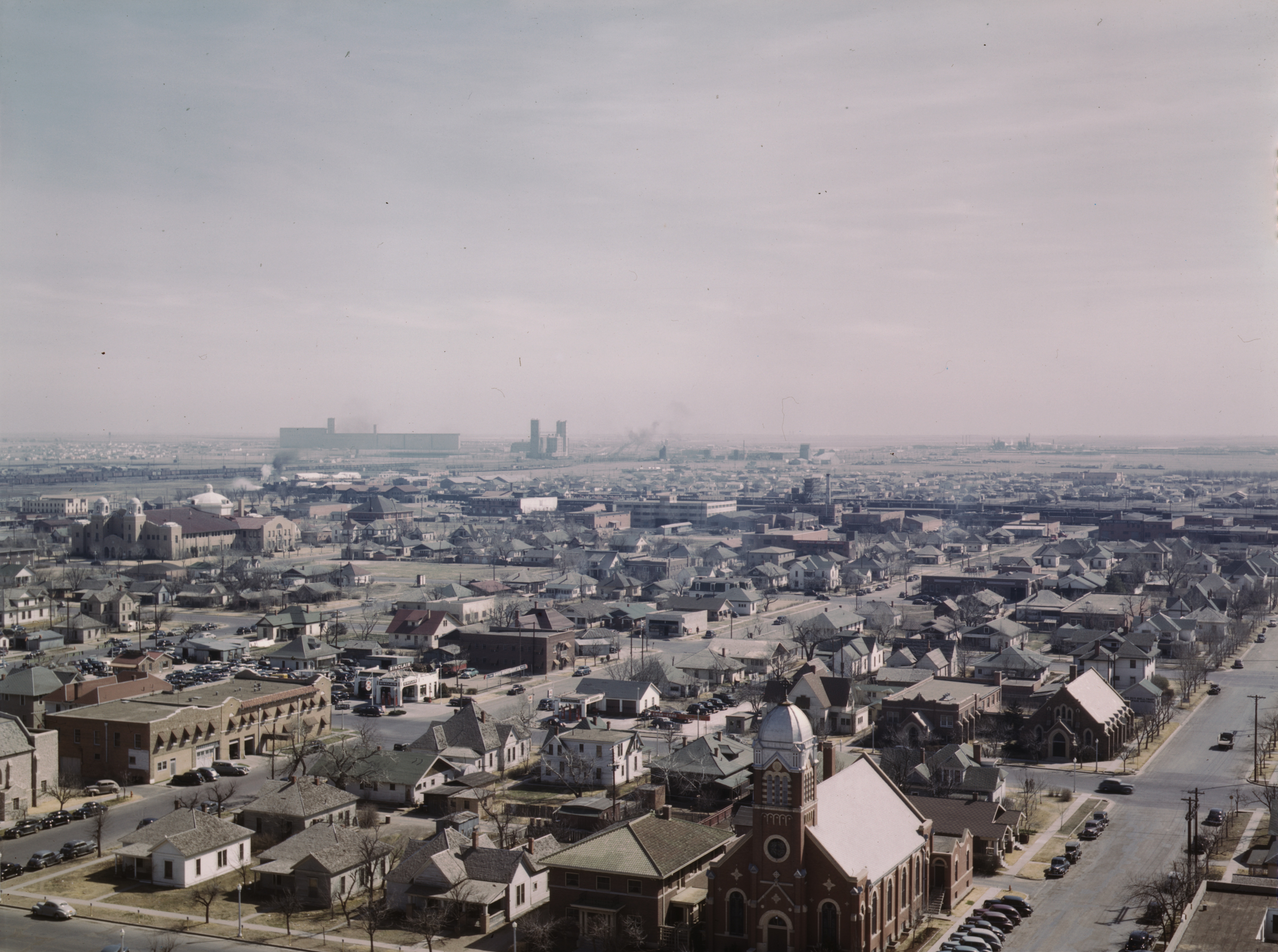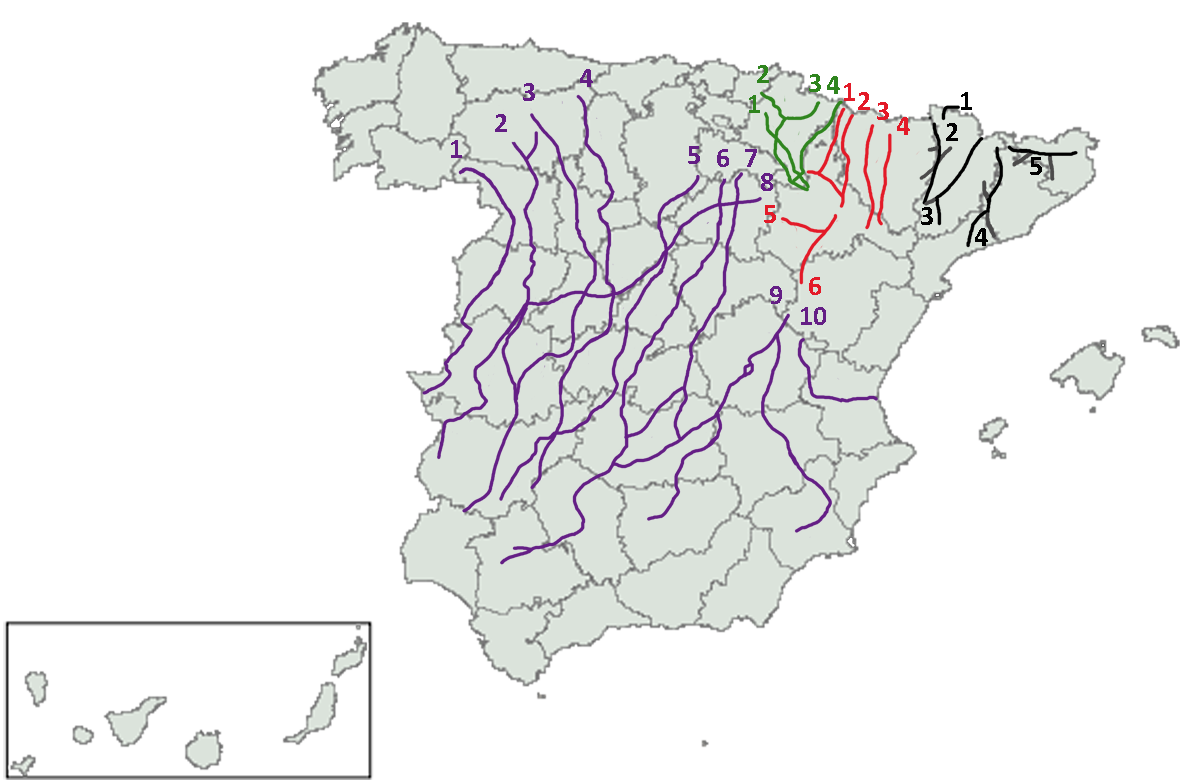|
Ranch Rodeo
A ranch rodeo is a traditional type of rodeo in which teams of cowboys or cowgirls from different ranches compete against each other in events based on the type of work they do every day. Ranch rodeos differ from the more common PRCA-style rodeos in several ways. For starters, the contestants are not professional rodeo cowboys; instead, they are usually full-time ranch hands who compete in annual ranch rodeos for fun and for bragging rights. The events in ranch rodeos are more similar to the tasks commonly performed on a ranch, and the equipment and tack used are the same as those used during everyday ranch work. Instead of competing as individuals, the contestants in ranch rodeos compete as a team representing the ranch they work for. Though there are often individual awards such as "Top Hand" and "Top Horse," the main prize is for the top overall ranch team. Sanctioning bodies include the Working Ranch Cowboys Association, which sponsors the World Championship Ranch Rodeo in ... [...More Info...] [...Related Items...] OR: [Wikipedia] [Google] [Baidu] |
Rodeo
Rodeo () is a competitive equestrian sport that arose out of the working practices of cattle herding in Spain and Mexico, expanding throughout the Americas and to other nations. It was originally based on the skills required of the working vaqueros and later, cowboys, in what today is the western United States, western Canada, and northern Mexico. Today, it is a sporting event that involves horses and other livestock, designed to test the skill and speed of the cowboys and Cowboy#Cowgirls, cowgirls. Professional rodeos generally comprise the following events: calf roping, tie-down roping, team roping, steer wrestling, bronc riding, saddle bronc riding, bronc riding, bareback bronc riding, bull riding, breakaway roping, and barrel racing. The events are divided into two basic categories: the timed events and rough stock events. Depending on sanctioning organization and region, other events such as goat tying and pole bending may also be a part of some rodeos. The "world's first pu ... [...More Info...] [...Related Items...] OR: [Wikipedia] [Google] [Baidu] |
Cowboy
A cowboy is an animal herder who tends cattle on ranches in North America, traditionally on horseback, and often performs a multitude of other ranch-related tasks. The historic American cowboy of the late 19th century arose from the ''vaquero'' traditions of northern Mexico and became a figure of special significance and legend.Malone, J., p. 1. A subtype, called a Wrangler (profession), wrangler, specifically tends the horses used to work cattle. In addition to ranch work, some cowboys work for or participate in rodeos. Cowgirls, first defined as such in the late 19th century, had a less-well documented historical role, but in the modern world work at identical tasks and have obtained considerable respect for their achievements. Cattle handlers in many other parts of the world, particularly South America and Australia, perform work similar to the cowboy. The cowboy has deep historic roots tracing back to Spain and the earliest European Settlement of the Americas, settlers of th ... [...More Info...] [...Related Items...] OR: [Wikipedia] [Google] [Baidu] |
Ranch
A ranch (from /Mexican Spanish) is an area of landscape, land, including various structures, given primarily to ranching, the practice of raising grazing livestock such as cattle and sheep. It is a subtype of farm. These terms are most often applied to livestock-raising operations in Mexico, the Western United States and Western Canada, though there are ranches in other areas.For terminologies in Australia and New Zealand, see Station (Australian agriculture) and Station (New Zealand agriculture). People who own or operate a ranch are called ranchers, cattlemen, or stockgrowers. Ranching is also a method used to raise less common livestock such as horses, elk, American bison, ostrich, emu, and alpaca.Holechek, J.L., Geli, H.M., Cibils, A.F. and Sawalhah, M.N., 2020. Climate Change, Rangelands, and Sustainability of Ranching in the Western United States. ''Sustainability'', ''12''(12), p.4942. Ranches generally consist of large areas, but may be of nearly any size. In the western ... [...More Info...] [...Related Items...] OR: [Wikipedia] [Google] [Baidu] |
Professional Rodeo Cowboys Association
The Professional Rodeo Cowboys Association (PRCA) is the largest rodeo organization in the world. It sanctions events in the United States, Canada, and Mexico, with members from said countries, as well as others. Its championship event is the National Finals Rodeo (NFR). The PRCA is headquartered in Colorado Springs, Colorado, United States.''2018 PRCA Media Guide" "Introduction'', ''About the PRCA'', p. 6. History The organization was created in 1936 when a group of cowboys walked out of a rodeo at the Boston Garden to protest the actions of rodeo promoter W.T. Johnson, who refused to add the cowboys' entry fees to the rodeo's total purse. Johnson finally gave in to the cowboys' demands, and the successful "strike" led to the formation of the Cowboys' Turtle Association. That name was chosen because, while they were slow to organize, when required they were unafraid to stick out their necks to get what they wanted, like turtles might do. Among the organizers was a woman; Alice ... [...More Info...] [...Related Items...] OR: [Wikipedia] [Google] [Baidu] |
Working Ranch Cowboys Association
The Working Ranch Cowboys Association (WRCA) was established in 1995 in Amarillo, Texas, United States, as a professional association for ranch owners, foremen, and cowboys. One of their stated goals was to keep the western heritage, ideals, and work ethics alive. The WRCA sanctions several ranch rodeos every year plus the World Championship Ranch Rodeo held every November in Amarillo. The WRCA rodeo events cater more to actual ranch work than do regular rodeos. The events include ranch bronc riding, team doctoring, wild cow milking, team branding, and team penning Team penning is a western equestrianism, equestrian sport that evolved from the common ranch work of separating cattle into pens for branding, doctoring, or transport. Today it is a fast-paced event that gives a team of three riders on horseback .... The WRCA Foundation, sponsored by the WRCA, provides assistance to cowboys and their families in times of serious needs and also provides a financial collegiate schol ... [...More Info...] [...Related Items...] OR: [Wikipedia] [Google] [Baidu] |
Amarillo, Texas
Amarillo ( ; Spanish language, Spanish for "yellow") is a city in the U.S. state of Texas and the county seat of Potter County, Texas, Potter County, though most of the southern half of the city extends into Randall County, Texas, Randall County. It is the List of cities in Texas by population, 16th-most populous city in Texas and the most populous city in the Texas panhandle. The estimated population of Amarillo was 200,393 as of April 1, 2020, comprising nearly half of the panhandle's population. The Amarillo metropolitan area had an estimated population of 308,297 as of 2020. The city of Amarillo, originally named Oneida, is situated in the Llano Estacado region.Rathjen, Fredrick W. ''The Texas Panhandle Frontier'' (1973). pg. 11. The University of Texas Press. . The availability of the railroad and freight service provided by the Fort Worth and Denver Railway contributed to the city's growth as a cattle-marketing center in the late 19th century.. Retrieved on January 25, 2007 ... [...More Info...] [...Related Items...] OR: [Wikipedia] [Google] [Baidu] |
Winnemucca, Nevada
Winnemucca () is the only incorporated city in Humboldt County, Nevada, United States, of which it is also the county seat. As of the 2020 United States census, 2020 census, the city had a total population of 8,431, up 14.0 percent from the 2010 census figure of 7,396. Interstate 80 in Nevada, Interstate 80 passes through the city, where it meets U.S. Route 95 in Nevada, U.S. Route 95. History and culture The town was named for the 19th-century Chief Winnemucca of the local Northern Paiute tribe, who traditionally lived in this area. Winnemucca, translated, means "the giver." The chief's daughter, Sarah Winnemucca, was an advocate for education and fair treatment of the Paiute and Shoshone tribes in the area. Their family all learned to speak English, and Sarah worked as an interpreter, scout and messenger for the United States Army during the Bannock War of 1878. In 1883, Sarah Winnemucca published the first autobiography written by a Native American woman, [...More Info...] [...Related Items...] OR: [Wikipedia] [Google] [Baidu] |
Livestock Branding
Livestock branding is a technique for marking livestock so as to identify the owner. Originally, livestock branding only referred to hot branding large stock with a branding iron, though the term now includes alternative techniques. Other forms of livestock identification include freeze branding, inner lip or ear tattoos, earmarking, ear tagging, and radio-frequency identification (RFID), which is tagging with a microchip implant. The semi-permanent paint markings used to identify sheep are called a paint or color brand. In the American West, branding evolved into a complex marking system still in use today. History The act of marking livestock with fire-heated marks to identify ownership has origins in ancient times, with use dating back to the ancient Egyptians around 2,700 BCE. Among the ancient Romans, the symbols used for brands were sometimes chosen as part of a magic spell aimed at protecting animals from harm. In English lexicon, the word "brand", common to most ... [...More Info...] [...Related Items...] OR: [Wikipedia] [Google] [Baidu] |
Team Penning
Team penning is a western equestrianism, equestrian sport that evolved from the common ranch work of separating cattle into pens for branding, doctoring, or transport. Today it is a fast-paced event that gives a team of three riders on horseback from 60 to 90 seconds (depending on the class or the sanctioning of the event) to separate three specifically identified cattle from a herd of 30, and put them into a 16' x 24' pen through a 10' opening, at the opposite end of the arena.Team Penning Retrieved on 4 May 2009 The sport features 30 head of cattle, typically yearling beef cattle (mature cows or bulls are not allowed), with numbers affixed to their back, three each wearing a number from 0 through 9 or with colored collars attached. Timing starts once the line judge has dropped his flag as the lead rider's horse crosse ... [...More Info...] [...Related Items...] OR: [Wikipedia] [Google] [Baidu] |
Wild Cow Milking
Wild cow milking is a rodeo event seen at mainstream and ranch rodeos. A team-based competition, the goal is to catch and milk a "wild" cow (a semi-feral animal that is not used to being milked by people, usually of a beef cattle breed) in as short a time as possible. The competition dates back at least to the early 20th century, with competitions at the Cheyenne Frontier Days rodeo photographed as far back as 1924. Rules Though the specifics can vary depending on the rodeo, the general rules for wild cow milking are: * Each team commonly consists of two, three, or more individuals. Ranch rodeo teams usually have four members. *Competitions may include cowboys on horses. If so, one or two team members are on horseback; the others are on foot. Other events have all team members afoot. *One individual (occasionally two), called the "mugger," is tasked with holding the animal's head. Another, the "milker," generally the fastest person on the team, attempts to milk the cow. Some ... [...More Info...] [...Related Items...] OR: [Wikipedia] [Google] [Baidu] |
Cowboy Culture
Cowboy culture is the set of behaviors, preferences, and appearances associated with (or resulting from the influence of) the attitudes, ethics, and history of the American cowboy. The term can describe the content or stylistic appearance of an artistic representation, often built on romanticized impressions of the wild west, or certain aspects of people's lifestyle, such as their choices in recreation (including enjoyment of Western movies and music), apparel, and western or southwestern cuisine. Origins The origins of cowboy culture go back to the Spanish vaqueros who settled in New Mexico and later Texas bringing cattle. By the late 1800s, one in three cowboys were Mexican and brought to the lifestyle its iconic symbols of hats, bandanas, spurs, stirrups, lariat, and lasso. With westward movement brought many distinct ethnicities all with their own cultural traditions. Welsh Americans, as one example, had a history in Wales of cattle and sheep droving, that incorporated well ... [...More Info...] [...Related Items...] OR: [Wikipedia] [Google] [Baidu] |
Ranches
A ranch (from /Mexican Spanish) is an area of land, including various structures, given primarily to ranching, the practice of raising grazing livestock such as cattle and sheep. It is a subtype of farm. These terms are most often applied to livestock-raising operations in Mexico, the Western United States and Western Canada, though there are ranches in other areas.For terminologies in Australia and New Zealand, see Station (Australian agriculture) and Station (New Zealand agriculture). People who own or operate a ranch are called ranchers, cattlemen, or stockgrowers. Ranching is also a method used to raise less common livestock such as horses, elk, American bison, ostrich, emu, and alpaca.Holechek, J.L., Geli, H.M., Cibils, A.F. and Sawalhah, M.N., 2020. Climate Change, Rangelands, and Sustainability of Ranching in the Western United States. ''Sustainability'', ''12''(12), p.4942. Ranches generally consist of large areas, but may be of nearly any size. In the western United S ... [...More Info...] [...Related Items...] OR: [Wikipedia] [Google] [Baidu] |
